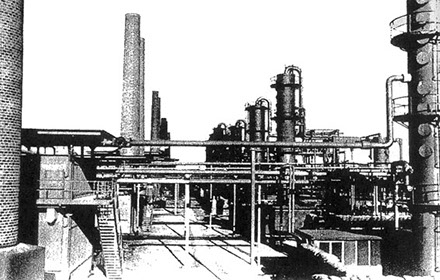Inexperienced Crews for SS Units? 1945? Seriously?
In my research of the 1945 war in Hungary, basically the Konrad Operations, Operation Fruhlungswachen and the Vienna Defensive Operation, I have come to an important conclusion: many AFV crews of the 6th SS Panzer Army were inexperienced.
I know that many readers are dubious, knowing that I have a deep-seeded antipathy toward SS forces in general. I acknowledge the fact and actually, wear it as a badge of honor. For the SS were NAZIS and pledged allegiance to Hitler and the NSDAP, not Germany.
I know that many readers are dubious, knowing that I have a deep-seeded antipathy toward SS forces in general. I acknowledge the fact and actually, wear it as a badge of honor. For the SS were NAZIS and pledged allegiance to Hitler and the NSDAP, not Germany.
However, I think I can make a very strong case for this.
First, there is training. In March of 1945, the Germans had stripped out most of their training program using vehicles. There simply was no fuel left and very little time to take soldiers from the most basic of military indoctrinating training to the highly technical training related to sophisticated vehicles like the Panther and Royal Tiger.
True, by this time the political training component had largely become superfluous, as the new recruits had grown up under the system of National Socialism and were heavily invested in the status quo. Also, by March of 1945 the war had devolved into a bitter struggle for survival not only of that system but of the German nation itself. Nevertheless, according to Gordon Rottman in German Pioneer, 1939-1945, even in the technical specialties, the Germans were still offering plenty of political indoctrination in 1945:
Almost every day there was some form of political indoctrination, lectures on history as seen by the Nazis, discussion of news events, lectures by local party officials, films, and similar (Ibid., page 10)
Royal Tigers consumed 2 gallons of highly processed gasoline per mile and, while the Germans were eating into their petroleum reserves for virtually all their needs. This was, in fact, the primary impetus for Fruhlungswachen: to regain some kind of control of any source of petroleum.
This underscores why the Royal Tiger was the wrong tank at the wrong time for the Third Reich. Most ASL'ers consider it the best tank of the war, but it shows how a tactical game can undermine a full appreciation of a tank's true value. With a paltry combat radius of about 75 miles, the fuel consumption of the Royal Tiger was metaphorically like handing out MG42's to an infantry squad with low ammo.
Major Shawn Keller, USAF, discusses how the lack of fuel created training problems for the Luftwaffe. As early as 1941, the Luftwaffe was running a deficit in its production of aviation fuel, resulting in "training" being conducted during non-combat missions. In other words, flight time was being logged by flying Ju52's to evacuate wounded or deliver spare parts.
By 1945, Germany was utterly dependent on synthetic fuel, lowering mileage and creating maintenance problems. Yet synthetic fuel, while a marvel and one of the truly great accomplishments managed by the Germans during the war, never came close to meeting military demands. It was highly vulnerable to allied bombing attacks and economically crippling. Synthetic fuel never accounted for more than 15% of fuel produced by the Germans came from synthetics.
 |
| German synthetic fuel plant in Police, Poland. |
So there was no fuel for practical training of the troops that would be using the Royal Tigers of Operation Fruhlungswachen. Unfortunately, the power plant, the Maybach v12, was used in a variety of tanks, allowing a some cross training between Panther, Tiger and Royal Tiger crews. So while it may have underpowered the massively heavier Royal Tiger, it did have advantages...yet it remained a complex engine and fuel shortages meant that crews would have been inexperienced in many practical details.
And crews were probably completely unprepared for the soft, mushy ground in Western Hungary. Royal Tigers were bogged so badly in Hungary that some actually sunk up to their turrets--that's one way to get hull down. This happened frequently enough that the Germans had a term for such vehicle crews--submariners.
Let's also look at the fuel problem related to these big guns. The guns themselves are heavy and unbalance the tank mightily. The turrets of these tanks, likewise, were massive. They required a power traverse (with a manual traverse for fine tuning.) It was virtually impossible to spin a turret using a manual traverse. The power traverse, on the Royal Tiger, required the engine to be running. No fuel. No turret traverse.
So, while there can be little doubt that Tiger crews in Fruhlungswachen were game and highly motivated, there is also reason to believe that their training was underwhelming. Do I think the official rule (D3.45) is applicable (Tiger crews normally have a morale of 9?)
3.45 INEXPERIENCED CREWS: A SSR may specify certain armed vehicles to have Inexperienced Crews. Each such crew is treated as if it contains an inherent 6+1 Armor Leader, which is not shown in counter form. Usage of this quasi- Armor Leader is the same as for any normal Armor Leader [EXC: his leadership modifier must be used whenever it is optionally usable by a normal Armor Leader; and the quasi-Armor Leader can never be eliminated or removed from its crew].
No. Clearly a morale of 6 is inappropriate. However, a +1 is applicable and also even highly motivated troops are likely to give up on a dead hulk that can't move or spin its turret. Dropping the morale of Tiger troops during the later stages of the war seems completely justified.


.jpg/450px-Bundesarchiv_Bild_101I-680-8282A-06%2C_Budapest%2C_Panzer_VI_(Tiger_II%2C_K%C3%B6nigstiger).jpg)



Comments